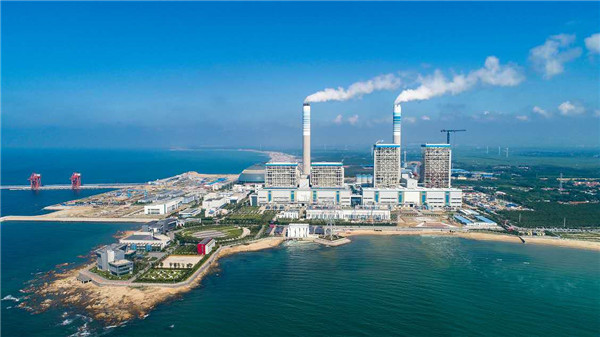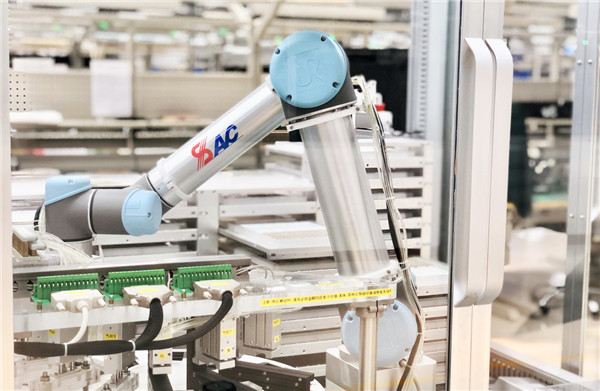CHD Powers up in Innovation-Driven Infrastructure Construction
China Huadian Corporation Ltd. (CHD) has been putting its emphasis on new infrastructure construction for several years and some relevant projects are now in operation or under construction.
Smart system improves production quality, efficiency
Construction of the first phase of CHD's pilot project of a smart coal-fired power plant in Laizhou of Shandong province began in 2007. When it was put into operation in 2012, it was the first smart ecological power plant in China to win the gold medal of the National Quality Engineering Award.
It was also the first of its kind to have generation units with installed capacity of 1 million kW.
Integrating seawater desalination, closed coal fields, circulating water-based power generation systems, boiler tiny-oil ignition, a dry bottom ash extraction system, a DCS plus DEH integrated system and an AMS smart device management system, the plant has the most advanced generation units and equipment in the power field in China.

Phase 2 of the smart coal-fired power plant in Laizhou of Shandong [Photo/sasac.gov.cn]
Following the principle of improving competitiveness with innovation, construction of phase 2 of the plant increased adoption of such information technology as the internet, the internet of things and artificial intelligence (AI) to develop smart coal-fired islands and smart security control systems as well as mobile applications for production management.
In 2019, two one million-kW generation units of the plant went into service, making the project China's first thermal power construction integrating such technologies as smart lighting, intelligent soot blowing, digital coal fields, GIL loop lines and a bootstrap smoke system.
The units also set records for the lowest coal consumption in China and were symbols of the advancement of the world's thermal industry.
Smart systems free people's hands and improve production efficiency.
At Guodian Nanjing Automation Co., Ltd., a subsidiary of CHD, several smart vehicles move around between workshops, transporting materials and screening starting voltage for different needs.
"Such work was done by four workers previously but now only one six-shaft mechanic arm is enough," an employee of the company said.
The overall production efficiency improved by 42.48 percent since the smart plant started operation, exceeding a reduction of 32 percent of human resource cost.
In addition, the first pass rate of quality improved by 13.25 percent and energy consumption was reduced by eight percent.

The intelligent mechanic arm at work in Guodian Nanjing Automation Co., Ltd. [Photo/sasac.gov.cn]
Such smart lines are used in all rely product productions and nearly 30,000 sets of such machines are made by the smart machines each year at the company.
They are also used in some national major projects like the supporting power project of the Hong Kong-Zhuhai-Macao Bridge and Beijing Daxing International Airport construction and are exported to more than 60 countries and regions.
In addition to a wide-use in such fields as high-speed railways, subways, ultra-high voltage transmission and digital power plants as well as smart traffic systems, the smart equipment played a role in safe power supply to Leishenshan and Xiaotangshan hospitals in Wuhan of Central China's Hubei province and Beijing during the COVID-19 outbreak.
CHD also developed a demonstration digital mine with an automatic fully mechanized coal face which was put into use in December 2019.
The system features functions including automatic coal-cutting, remote start and turnoff, full video monitoring, voice talk between people in and out of the shaft and automatic adjustment and replenishing, which are valuable experience for future smart shaft construction.
Docking with national energy overall layout
Hydropower has been regarded as the safest clean and renewable energy source with the most mature technology in the world. Development of such power plays a significant role in construction of ecological civilization and livelihoods.
Although with a total installed capacity of 350 million kW and accounting for 66 percent of the renewable power generation, the development rate of water resources is still less than 60 percent in China.
Most of the undeveloped hydro-resources are located in Southwest China's Sichuan and Yunnan provinces and the Tibet autonomous region which are now focuses in future plans for hydropower projects.

Blowers of one of CHD's wind farm in Gansu [Photo/sasac.gov.cn]
CHD is responsible for construction of a hydropower project in the border area between Sichuan and Tibet on the upstream of the Jinsha River.
The project includes construction of eight hydropower plants with a total installed capacity of nearly 10 million kW. It has been listed in China's 13th Five-Year Plan (2016-20).
The company recently made a new plan to invest nearly 300 billion yuan ($42.40 billion) in construction of a large-scale renewable energy demonstration base featuring a 10 million kW hydropower plant and a 20 million kW wind-solar power plant.
The integrated project is the first attempt in China. If succeeded, it will be significant in sustainable development of hydropower, energy security and energy structure optimization in China as well as reduction of emissions in accordance with the Paris Agreement on climate change.
According to the company, projects along the upstream of the Jinsha River in Sichuan and Tibet can help increase relevant industries output by a value of more than 700 billion yuan.
So far, the four power plants under construction have greatly improved local infrastructure and created nearly 300 million yuan. They provided thousands of jobs for local people by developing local industries and supporting employment.
CHD is also concerned about environmental protection during construction. Measures of planting trees and releasing fish as well as approaches to conserving water and soil and treating waste have been carried out.
At present, two fish breeding stations have been built and more than 700,000 fish released. It's worth mentioning that in the construction of the four power plants underway, nearly 3.5 billion yuan have been applied to environmental protection.
Structural transformation boosts new energy development
With the rapid change of the global energy structure in recent years, a new round of energy revolution is underway. CHD has emphasized strategic transformation in aspects of promoting wind and solar power as well as comprehensive energy service and intends to evolve into a leading enterprise in new energy fields.
CHD's branch in Gansu province, the enterprise's only regional subsidiary using only clean energy as power, is devoted to providing safe, economic, green and low-carbon power supply to the public.
The company now has an installed capacity of 2.1 million kW with 1.75 million kW of wind power and 350,000 kW of photovoltaic power.
Taking full advantage of rich clean energy resources and the mature industrial bases in the region, the company has cooperated with other enterprises including Dongfang Electric Corporation and Southwest Electric Power Design Institute of China Energy Engineering Group Co., Ltd. to build a coordinative industrial pattern integrating such resources as wind, solar, water, fire, storage, pumped storage and thermal power in 2020.
CHD in the Inner Mongolia autonomous region is now working on several projects of transmitting wind power-generated ultra-high voltage electricity to other regions. The project will greatly promote regional economic development, increase local employment and form harmonious relations between the government and enterprises as well as enterprises and the public.
Wind power projects in Shanxi province are also going on smoothly and are expected to start operation this year.
A new photovoltaic power project was also signed early March this year, marking the start of the construction of a 2 million kW photovoltaic power demonstration base in the Pinglu district of Shuozhou in Shanxi. Upon completion, about 3.2 billion kWh of power is expected to be produced annually.
Digitalization is also included in CHD's energy structural transformation plan.
CHD's Gansu subsidiary has the only new energy remote supervising center approved by the provincial energy regulatory office and power dispatching center.
By using varieties of cutting-edge technologies including a cloud examination platform, infrared unmanned aerial vehicle (UAV) checking, remote diagnosis and a wind power prediction system, digitalized production and operation are greatly improved.
A smart UAV inspection system was also developed in CHD's Huawei photovoltaic power plant in Shanxi.
Based on machine vision, image recognition technology, SLAM algorithm and big data, the system can help improve inspection efficiency, position the fault point and diagnose, analyze and give guidance to maintenance, which greatly reduces shut-off periods and electricity loss.
CHD has developed new technology, promoted new industry and adopted the idea of new infrastructure into all aspects of production.
The company will continue to work on new infrastructure and advanced technology to contribute to China's high-quality economic development.
(Executive editor: Zhang Tianyuan)



